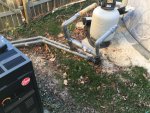There have been several posts questioning whether or not to install a heater bypass in the pool plumbing to divert water prior to entering the heater. I conducted a little study on my own pool equipment to see if there were any gains from using a heater bypass when there was no need to heat the pool.
Bypass Open
RPM___________Watts __________GPM
3250...........................2666..............................117
3300...........................2794..............................119
1250...........................208................................40
1200...........................192................................38
Bypass Closed
RPM_________Watts __________GPM
3250...........................2545..............................107
3300...........................2665..............................109
1250............................154...............................13
1200............................148...............................12
From what I've gathered, for those with single speed pumps that operate at higher RPM's, there is little to be gained from a heater bypass since I only saw a difference of 10 GPM. For those that have variable speed pumps and run them at lower speeds, then there is a definite gain from using a bypass. This of course, assumes that the pump time is reduced to compensate for the higher GPM since a higher flow rate at the same RPM draws more watts.

The bypass valve is in the middle of the top right corner (in the bypass open position). All plumbing to the heater is 2.5" with a 2.5" Pentair FullFlo check valve (spring removed). The remainder of the plumbing is 3".
This information was gathered from the use of Mark's (Mas985) spreadsheet. It is possible that there are discrepancies at the lower RPMs/Watts, but there is a very notable difference in water velocity from the return jets at the lower RPMs with the bypass open.
To avoid having stagnant water sitting in the heater for long periods of time, I programmed a schedule to allow water to circulate through the heater 15 mins a couple times per week.
I hope this clears up any confusion as to the benefits of a heater bypass.
Bypass Open
RPM___________Watts __________GPM
3250...........................2666..............................117
3300...........................2794..............................119
1250...........................208................................40
1200...........................192................................38
Bypass Closed
RPM_________Watts __________GPM
3250...........................2545..............................107
3300...........................2665..............................109
1250............................154...............................13
1200............................148...............................12
From what I've gathered, for those with single speed pumps that operate at higher RPM's, there is little to be gained from a heater bypass since I only saw a difference of 10 GPM. For those that have variable speed pumps and run them at lower speeds, then there is a definite gain from using a bypass. This of course, assumes that the pump time is reduced to compensate for the higher GPM since a higher flow rate at the same RPM draws more watts.

The bypass valve is in the middle of the top right corner (in the bypass open position). All plumbing to the heater is 2.5" with a 2.5" Pentair FullFlo check valve (spring removed). The remainder of the plumbing is 3".
This information was gathered from the use of Mark's (Mas985) spreadsheet. It is possible that there are discrepancies at the lower RPMs/Watts, but there is a very notable difference in water velocity from the return jets at the lower RPMs with the bypass open.
To avoid having stagnant water sitting in the heater for long periods of time, I programmed a schedule to allow water to circulate through the heater 15 mins a couple times per week.
I hope this clears up any confusion as to the benefits of a heater bypass.



